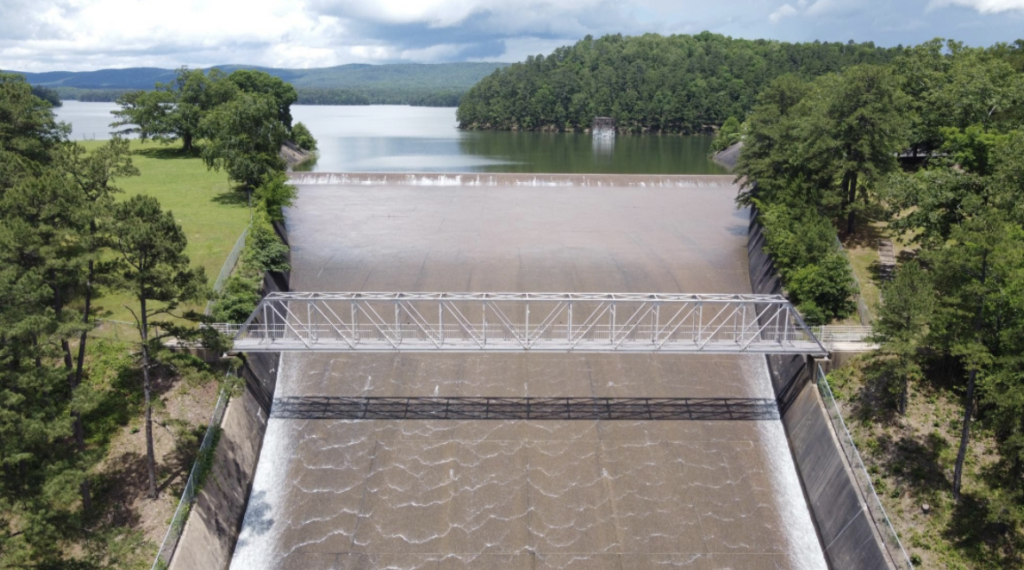Water utilities provide drinking, wastewater, and stormwater services to millions of people across the United States, including for residential, commercial, and industrial uses. These essential service providers are responsible for offering safe and affordable resources to their customers, which include identifying, protecting, and enhancing a drinking water source, pumping water from the source to a water treatment facility to be cleaned, filtered, and disinfected, distributing water to residential, commercial, and industrial users, tracking water use, improving water infrastructure (pipes, filtration plants, etc.), and collecting, cleaning, and discharging used water. Water utilities have long relied on traditional, “gray” infrastructure, such as pipes and treatment plants, to meet these responsibilities. Yet as utilities face growing threats to the delivery of essential services, new investments and priorities, including in natural (green) infrastructure like eco-roofs, forested watersheds, and bioswales, must be considered.
Water utilities have an obligation to mitigate risks to business operations and delivery services. The top five challenges facing the water industry, according to the American Water Works Association’s (AWWA) 2020 State of the Water Industry survey, which collected responses from over 3,000 water professionals from across the United States, are as follows:
- Renewing and replacing aging water and wastewater infrastructure,
- Financing for capital improvements,
- Long-term water supply availability,
- Public understanding of the value of water systems and services, and
- Watershed/source water protection.
Respondents to the same survey reported that extreme weather events and climate change are among the top five macro phenomena threatening the water sector. Since 1980 there have been 259 weather and climate disasters in the United States where “overall damages/costs for each event have reached or exceeded $1 billion.” In 2019 alone there were 14 such events (three major floods, eight severe storms, two tropical cyclones, and one wildfire event) that resulted in losses of over US$1 trillion. The water industry is well aware of these challenges: over 90 percent of utilities have, or are in the process of implementing, an emergency preparedness plan and nearly 70 percent of utilities have, or in the process of developing, a risk and resilience assessment (AWWA 2020).
Though the challenges water utilities are facing across the country vary, many regions are experiencing overlapping issues, such as drought, harmful algal blooms, nonpoint source pollution, and per- and polyfluoroalkyl substances (PFAS [harmful toxins]). For example, water utilities in Oregon are concerned about the risks posed by wildfire and drought. In Texas, utilities are similarly concerned about the Western drought and are exploring creative solutions to address water supply concerns. In Colorado, water utilities are grappling with the impacts of last year’s fires and working on restoration and erosion prevention strategies in multiple watersheds (Fountain 2021). On the East Coast, water utilities are facing challenges from hurricanes and flash flood events, downstream flooding triggered by development projects, and agricultural runoff/pollution.
Natural (green) infrastructure refers to “a strategically planned network of natural and working lands, such as forests, rivers, wetlands, and waterways that conserve and enhance ecosystem values and functions, and provide associated benefits for safe and healthy communities and vibrant local economies” (100-Year Water Vision). Examples of natural infrastructure strategies include:
- Streamside vegetation plantings to reduce pollutants from entering waterways,
- Wastewater wetlands to cost-effectively cool water and/or absorb harmful toxins,
- Floodplain restoration to enable fluctuating river levels, and
- Eco-roofs, bioswales, permeable pavements, and rain gardens to filter sediment and minimize pollutants carried by stormwater runoff.
Natural infrastructure strategies, or hybrid systems that integrate “green” and “gray” infrastructure, are often less expensive than traditional infrastructure projects alone, can provide high returns on investment, and offer many co-benefits such as recreation and diversified income opportunities (Browder Et al. 2019, WP and OEC, Hanson 2011). For example, “New York saved 22 percent, or $1.5 billion, by combining green and gray infrastructure instead of pursuing a gray-only strategy to secure water for the city” (Browder Et al. 2019). As such, natural infrastructure offers a compelling opportunity for water utilities to address many of their most pressing concerns and challenges.

Figure 1. Central Arkansas Water’s spillway below their forested reservoir (an example of green-gray infrastructure).
Courtesy of Central Arkansas Water, photo credit: Matt Phillips
There are a number of direct benefits to natural infrastructure investment, such as enhanced resilience of built systems, and cost savings associated with lower treatment costs, as well as co-benefits, such as new revenue streams from sustainable timber harvesting, increased carbon sequestration, and increased access to recreation. Despite these advantages, integrating natural infrastructure in utility financing approaches for infrastructure remains a challenge. Common barriers utilities face to implementing natural infrastructure include:
- A perceived lack of revenue-generating and cost savings associated with natural infrastructure,
- Concerns about if natural infrastructure can meet the regulatory requirements of utilities, which requires both regulating agencies and contractors to recommend, design, and implement,
- A lack of awareness or understanding about the relationship between degraded ecosystems and water delivery services, which makes it difficult to prioritize investing in watershed-scale, natural infrastructure strategies,
- The need to collaborate with many partners, often across a mosaic of ownerships and sector-expertise, including “state and federal agencies, infrastructure providers, and natural infrastructure specialists” can be difficult to navigate and thus stymie natural infrastructure investment (WP and OEC),
- Certain natural infrastructure strategies, such as source water protection, are often viewed as secondary investments to immediate upgrades (like pipes) and are thus deprioritized, and
- The belief and/or perception that ratepayers are not willing to invest in natural infrastructure can hinder the integration of natural infrastructure in water management planning.
Amidst these challenges, a number of utilities and cities have successfully invested in natural infrastructure projects, setting a precedent for more widespread interest and investment in the multi-faceted approach to water management. The following successful case studies offer important insights for the future of natural infrastructure investment.
The Portland Water District in Portland, Maine provides drinking water from Sebago Lake to about 16 percent of the state’s population (PWD). The Sebago Lake watershed is 440 square miles and over 80 percent forested. The District prioritizes and invests in source water protection, an example of watershed-scale natural infrastructure investment, by working closely with land conservation partners and providing funding for eligible projects through the Watershed Land Conservation Program (established in 2013). The program stipulates that the District can provide up to a 25 percent match for the cost of the land acquisition, a funding formula that has been used to help protect over 5,000 acres of forestland in the watershed (ibid). The District is also a founding member of Sebago Clean Waters, a coalition of nine organizations that work to “protect water quality, community well-being, a vibrant economy, and fish and wildlife habitat in the Sebago watershed through voluntary forestland conservation” (ibid).
In Oregon, the Eugene Water & Electric Board (EWEB) provides drinking water to about 200,000 customers. EWEB has been working with local partners for over a decade on a drinking water source protection program, the Pure Waters Program (PWP) (WO and OEC). The program includes EWEB, McKenzie Watershed Council, the Upper Willamette Soil & Water Conservation District, McKenzie River Trust, the Metropolitan Wastewater Management Commission, University of Oregon, and the US Forest Service, among others. PWP has pursued a number of strategies to increase and improve vegetated riparian systems to protect water quality. For example, PWP works with landowners to establish long-term agreements, which designate PWP as responsible for the planting and maintenance of the vegetated riparian area. In exchange, landowners agree not to remove vegetation or otherwise threaten the buffer zone. Investing in riparian buffers helps reduce erosion, provides habitat for fish and wildlife, and creates jobs (NI in Oregon and EWEB). In addition, PWP is encouraging landowners to adopt Firewise practices, which are designed to reduce the risk of damage to homes and structures (EWEB), thus also reducing short- and long-term impacts of fire, such as erosion, which can impact water quality. EWEB is also in the process of obtaining reimbursements from the Federal Emergency Management Agency (FEMA) for the utility’s riparian restoration work on properties that were significantly damaged by the 2020 Holiday Farm Fire.
The City of Portland, Oregon prioritizes investment in natural infrastructure to manage stormwater runoff, which carries pollutants to waterways and can cause erosion and flooding. To incentivize stormwater management, Portland offers a discount of up to 100 percent on stormwater management charges for ratepayers (residential or commercial) who integrate practices on their property that reduce runoff (The City of Portland). The program, Clean River Rewards, encourages customers to increase the area of pervious surfaces–those that allow stormwater to infiltrate–on their properties, thus reducing the amount of pollution entering the city’s waterways. Examples of natural infrastructure practices that can increase the amount of stormwater infiltration include eco-roofs, bioswales, permeable pavements, and rain gardens. EWEB and the City of Portland’s natural infrastructure investment efforts are among a number of innovative efforts and partnerships at the forefront of natural infrastructure investment.

Figure 2. A bioswale in New Haven, Connecticut (an example of green-gray infrastructure).
Courtesy of Urban Resources Initiative, photo credit: Matthew Viens
There are a number of funding/financing strategies utilities and cities can draw on to bolster investment in natural infrastructure, including watershed protection programs, public-private partnerships, and financing mechanisms like green bonds.
Works Cited
AWWA. 2020 State of the Water Industry Report. American Water Works Association, 2020.
Browder, Greg, et al. Integrating Green and Gray: Creating Next Generation Infrastructure. World Resources Institute and World Bank, 2019.
DC Water. DC Water’s Pioneering Environmental Impact Bond a Success. 27 May 2021, https://www.dcwater.com/whats-going-on/news/dc-water%E2%80%99s-pioneering-environmetal-impact-bond-success.
EWEB. Pure Water Partners Program. http://www.eweb.org/community-and-environment/mckenzie-watershed-protection/landowner-assistance-programs/pure-water-partners.
Fountain, Henry. “Wildfires Threaten Urban Water Supplies, Long After the Flames Are Out.” The New York Times, 24 June 2021. NYTimes.com, https://www.nytimes.com/2021/06/24/climate/wildfire-water-quality.html.
Hanson, Craig. “Forests and Water: Green Infrastructure Can Be Less Expensive Than Gray Infrastructure.” World Resources Institute, 25 Feb. 2011, https://www.wri.org/data/forests-and-water-green-infrastructure-can-be-less-expensive-gray-infrastructure.
Oregon’s 100-Year Water Vision Definitions. Oregon Government, https://www.oregon.gov/oweb/resources/OregonWaterVision/Pages/details.aspx.
Portland Water District. “Land Conservation.” Portland Water District, 13 June 2019, https://www.pwd.org/land-conservation.
Portland Water District. “Water.” Portland Water District, 20 Jan. 2015, https://www.pwd.org/water.
The City of Portland. Stormwater Discount Program. https://www.portlandoregon.gov/bes/41976.
Willamette Partnership, and Oregon Environmental Council. Natural Infrastructure in Oregon, Common Challenges, Opportunities for Action, and Case Studies. Willamette Partnership and Oregon Environmental Council.
Lily Colburn, Western Resource Fellow | Lily Colburn is a Master of Environmental Management candidate at the Yale School of the Environment studying nature-based solutions, conservation, and food systems. Prior to Yale, Lily worked at the Smithsonian Tropical Research Institute (STRI) in Panama, studying the effects of reduced rainfall on root morphology and nutrient cycling. She has also spent time guiding backcountry trips in the Sierra Nevada. Lily holds Bachelor of Arts degrees in geography and English literature from the University of California, Los Angeles (UCLA). See what Lily has been up to. | Blog

